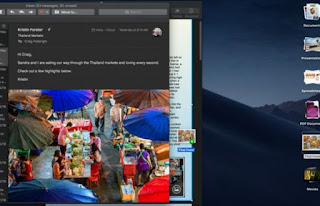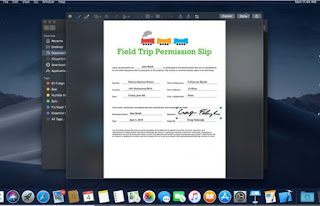At WWDC today (June 4), Apple's Senior Vice President Craig Federighi revealed a lot of new Mac features, and a new name. Yes, macOS 11.14 Mojave is coming to users this fall.
Highlights of this new, free update include a universal dark mode, a dynamic desktop, a Finder that photographers will love and a version of Safari with even more privacy-focused tools than before.
Apple also improved screenshots in ways that iPhone and iPad users will find familiar. Oh, and Apple announced the baby steps its taking to bring iOS apps to the Mac, including four of its own titles -- Apple News, Stocks, Voice Memos and Home.
This feature allows you to take all of the user interfaces in your Mac's apps, and turn them from bright to dark hues. Federighi said apps really pop against a white background, and while I'm inclined to believe him, I'm mostly happy to have a native feature that means my eyes will be hit with less bright light.
Highlights of this new, free update include a universal dark mode, a dynamic desktop, a Finder that photographers will love and a version of Safari with even more privacy-focused tools than before.
Apple also improved screenshots in ways that iPhone and iPad users will find familiar. Oh, and Apple announced the baby steps its taking to bring iOS apps to the Mac, including four of its own titles -- Apple News, Stocks, Voice Memos and Home.
- Dark Mode
This feature allows you to take all of the user interfaces in your Mac's apps, and turn them from bright to dark hues. Federighi said apps really pop against a white background, and while I'm inclined to believe him, I'm mostly happy to have a native feature that means my eyes will be hit with less bright light.
- Dynamic Desktop
For those users who spend their whole day with their eyes trained on their laptop, Dynamic Desktop will give you cues about what's happening. Not only will your background image change to fit the mood, but the menu bar and interface will move to Dark Mode once the sun sets, with background images to match your time of day.
- Desktop Stacks
Messy desktops be damned. Apple's looking to stop users from filling their whole desktop with files by introducing a new feature called Stacks. This tool will automatically group files by kind, with categories including documents, photos, PDFs, spreadsheets and movies. Scrolling across a stack allows you to preview it.
- Gallery View with Quick Actions
Apple's introduced a new way of looking at your files: Gallery view. Made for photographers, it allows you to skim through files where are arranged in a row on the bottom of the screen. Once you click on an image to view it at a larger scale, you'll also get the option for a right-side menu to see image metadata.
Also, Gallery View comes with Quick Actions, so you can easily rotate, crop and trim images, and create PDFs from a series of files. And if a small detail I noticed in Apple's presentation is to be believed, you'll also be able to quickly add password protection to files.
- Quick Look gets more editing tools
Hitting the Space bar while selecting an item has long activated Quick Look, where you can see your photo larger, or flip through a Document. Movjave supercharges this mode, allowing for image and document markup with signatures.
- Screenshots improved, like iOS
Just as it goes on iOS 11, screenshots will now lead to thumbnails appearing in the bottom right (though it's the left on the iPhone). Tapping it there opens the screenshot for markup, and Apple's giving users better tools for editing their screenshots, such as a sharpen tool. Also, a new on-screen interface provides a series of buttons to make it super easy for you to capture video.
- Continuity improved
For many of us, our smartphone is also our best camera, and the Mac will take better advantage of that in Mojave. First of all, Continuity Camera will let you use your Mac to take a photo from your smartphone, and have it immediately imported. Also, if you're tired of hand-scanning documents, the iPhone camera can be your new scanner, dropping adjusted documents to your desktop.
- iOS Apps on the Mac
Mojave is bringing some iOS apps to the Mac, including Apple News, which should look great on a bigger screen. Stocks is also coming, bringing interactive charts and ways to check for news stories tied to the companies you're tracking. Voice memos -- which Apple just brought to the iPad -- is also on the Mac, and gives you an easy drag and drop interface. The Home app, for keeping tabs on your smart home, rounds out the latest apps from Apple.
- Even More Privacy, Security
Apple's long prided itself on how its devices give users more privacy and security than those from other companies. The first of its new privacy initiatives will let users know when an app is trying to access your personal data, as well as your computer's camera and microphone.
Safari is also getting new tricks, actively thwarting the social media buttons in websites that stalk your activity (though it will let you white-list the services you want to keep tabs on you).
Mojave's also going to make it harder for sites to create a unique 'fingerprint' of your computer, which are made by collecting unique characteristics of systems. This way, your Mac looks like all others.
- 32-person FaceTime
First announced as a part of iOS 12, the new FaceTime, which will allow you to integrate your Animoji and Memoji faces, is also coming to macOS. Thankfully, this group chat, with a 32-user limit, looks a lot better on the Mac's larger screen than it does on an iPhone
- Mac App Store gets a fresh, familiar coat of paint
Since the Mac App Store is a trusted place to download apps, it's good that Apple's decided to refine it. The new-look Mac App store looks a little like its iOS counterpart, but more like the Mac Apple News app, with a sidebar and larger art. Also, videos give you a sense of how the app actually works.
Sections include Discover, Create, Work, Play and Develop. App updates will still download from the Mac App Store. Major titles announced for the store include BBEdit, Office 365, Lightroom and Transmit.
- Oh and one more thing, in the future
This isn't a Mojave feature, but in fact something to expect in macOS 11.15 or 11.16. Apple's looking to bring iOS apps onto the Mac, by adding iOS's UIKit technology, and tested this out by bringing Apple News, Stocks, Voice Memos and Home over. This technology isn't coming to macOS any time soon, as developers won't be getting access until 2019.
Some snaps of Apple WWDC 2018:












Comments
Post a Comment